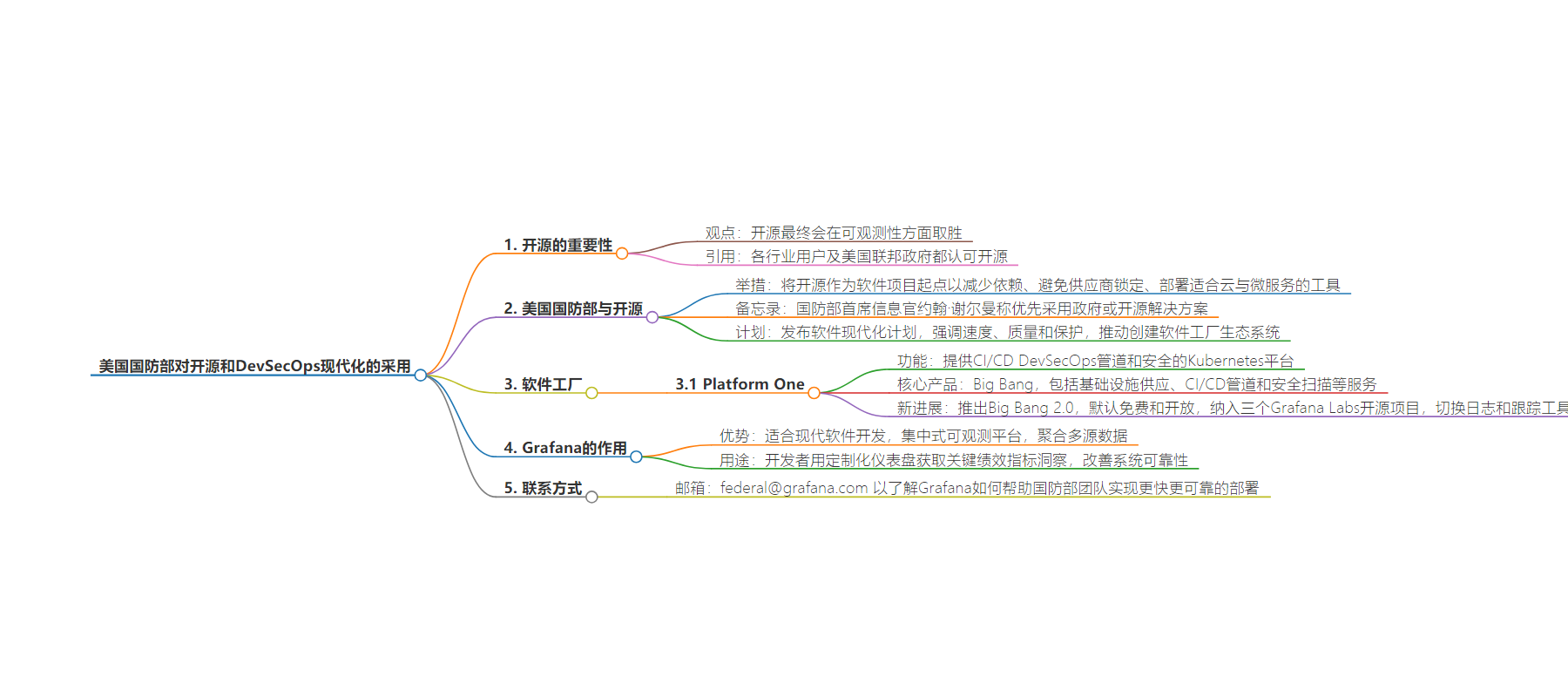包阅导读总结
1. 关键词:DoD、OSS、Grafana、DevSecOps、软件现代化
2. 总结:本文探讨了美国国防部(DoD)在软件开发现代化进程中优先采用开源软件(OSS),并以 Grafana 为支持。DoD 利用 OSS 减少依赖和避免供应商锁定,创建软件工厂生态系统,其中 Platform One 的 Big Bang 2.0 纳入了 Grafana 相关开源项目,Grafana 适用于现代软件开发,有助于 DoD 更高效可靠的部署。
3. 主要内容:
– 美国国防部(DoD)软件开发现代化
– 广泛使用 OSS 减少依赖,避免供应商锁定
– 发布软件现代化计划,推动创建软件工厂生态系统
– 软件工厂提供商 Platform One
– 提供 CI/CD DevSecOps 管道和安全的 Kubernetes 平台
– 其 Big Bang 2.0 降低使用门槛,免费且开放,纳入 Grafana 相关开源项目
– Grafana 的作用
– 是集中式可观测性平台,聚合多样源数据
– 开发者可用定制化仪表盘获取关键指标洞察,提升系统可靠性
– 有助于 DoD 团队更快速、可靠的部署
思维导图:
文章来源:grafana.com
作者:Grafana Labs Team
发布时间:2024/6/20 15:17
语言:英文
总字数:615字
预计阅读时间:3分钟
评分:86分
标签:devops,grafana,loki,tempo,开源软件
以下为原文内容
本内容来源于用户推荐转载,旨在分享知识与观点,如有侵权请联系删除 联系邮箱 media@ilingban.com
When it comes to observability, we believe open source will win in the end. It’s a sentiment shared by a wide spectrum of users, whether they work in auto manufacturing, banking, or shipping.
The U.S. federal government is yet another industry to prove this, showing that even those operating under the strictest security and compliance requirements see OSS as their preferred approach. In this blog post, we’ll take a brief look at how the Department of Defense is prioritizing open source as part of a broader push to modernize its software development, and how Grafana can support those efforts.
OSS and software factories
The DoD has used open source extensively for decades, but it has increasingly become the starting point for Defense software projects as a means to reduce dependencies, avoid vendor lock-in, and deploy tooling built for cloud and microservices. In a 2022 memo, DoD CIO John Sherman wrote that the department prefers “adopting existing government or OSS solutions before buying proprietary offerings,” adding that “OSS forms the bedrock of the software-defined world and is critical in delivering software faster.”
And last year, the DoD publicly released a software modernization plan that prioritized not only speed, but better quality and protections in software development and management. A big part of that shift is the push to create an ecosystem of software factories, which create a framework of tools and processes to automate many of the underlying components used by developers. For the DoD, that means creating a continuous development pipeline anchored in DevSecOps principles.
OSS forms the bedrock of the software-defined world and is critical in delivering software faster.
U.S. DoD CIO John Sherman
A coalition of software factory providers has begun to emerge, with an emphasis on building an open ecosystem. One of those providers, Platform One, hosts CI/CD DevSecOps pipelines and offers a secure Kubernetes platform for hosting microservices. Platform One’s core offerings include Big Bang, a customizable platform designed to accelerate software development and deployment within the DoD. It provides a comprehensive suite of tools and services, including infrastructure provisioning, CI/CD pipelines, and security scanning, and it’s currently being used by DoD branches such as the Air Force, Army, and Navy.
Last year, Platform One launched Big Bang 2.0 to lower the barrier for entry and make the platform free and open by default. A big part of that release was the inclusion of three Grafana Labs open source projects: Grafana Loki for logs, Grafana for visualization, and Grafana Tempo for traces.
Big Bang’s default stack has switched from a combination of Elasticsearch, Fluentbit, and Kibana to Promtail, Loki, and Grafana, with Platform One citing the lower resource cost for users and the lack of license requirements for core features. As part of that shift, Big Bang 2.0 also moves tracing from Jaeger to Tempo because it integrates better with its stack.
How DoD software factories can rely on Grafana
Grafana is well suited for modern software development, regardless of industry. It’s a centralized observability platform that aggregates data from diverse sources, including infrastructure, applications, and network devices. This allows software factories to gain a comprehensive view of their entire ecosystem in a single pane of glass, enabling proactive detection and resolution of issues.
Developers can use customized, role-based dashboards to get immediate insights into key performance indicators (KPIs), such as build and deployment metrics, system uptime, and resource utilization. They can also use Grafana to improve system reliability by identifying bottlenecks and inefficiencies in their delivery processes.
To learn more about how Grafana can help DoD teams deliver faster, more reliable deployments, email us at federal@grafana.com. And check out our other blog posts highlighting how the DoD is deploying Grafana.
